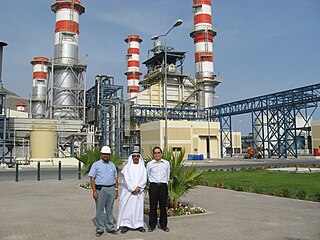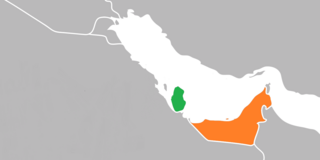
The United Arab Emirates is situated in the Middle East and West Asia, bordering the Gulf of Oman and the Persian Gulf, between Oman and Saudi Arabia; it is at a strategic location along the northern approaches to the Strait of Hormuz, a vital transit point for world crude oil. The UAE lies between 22°50′ and 26° north latitude and between 51° and 56°25′ east longitude. It shares a 19 km (12 mi) border with Qatar on the northwest, a 530 km (330 mi) border with Saudi Arabia on the west, south, and southeast, and a 450 km (280 mi) border with Oman on the southeast and northeast.
Ahmed Ali Al Sayegh is an Emirati politician who is a minister of state in the United Arab Emirates since 19 September 2018.

Consolidated Contractors Company (CCC) is the largest construction company in the Middle East and ranks among the top 25 international contractors with a revenue of US$5.3 billion in 2013 and 1.872 billion by 2020. CCC has offices and projects in over 40 countries, and in 2033 had a workforce of 36,000 employees. In April 2019, CCC was engaged in 40 ongoing projects globally. The majority of its sales are in the Middle East.

The Abu Dhabi National Oil Company, known by its acronym ADNOC, is the state-owned oil company of the United Arab Emirates (UAE).

QatarEnergy LNG, formerly Qatargas, is the world's largest liquefied natural gas (LNG) company. It produces and supplies the globe with 77 million metric tonnes of LNG annually from across its seven ventures—QatarEnergy LNG N(1), QatarEnergy LNG N(2), QatarEnergy LNG N(3), QatarEnergy LNG N(4), RL1, RL2 and RL3. It is headquartered in Doha, Qatar, and maintains its upstream assets in Ras Laffan, Qatar. Natural gas is supplied to the company's LNG trains from Qatar's North Field, by far the world's largest non-associated gas field. It reached a record LNG production of 77 million tonnes per year in December 2010. According to Brand Finance, QatarEnergy LNG is the world's fastest growing oil and gas brand in 2023. QatarGas is said to be used through gas diplomacy as leverage by Qatar on the EU and India to advance its interests and silence criticism of its human rights violations and corruption.

QatarEnergy, formerly Qatar Petroleum (QP), is a state owned petroleum company of Qatar. The company operates all oil and gas activities in Qatar, including exploration, production, refining, transport, and storage. The President & CEO is Saad Sherida al-Kaabi, Minister of State for Energy Affairs. The company's operations are directly linked with state planning agencies, regulatory authorities, and policy making bodies. Together, revenues from oil and natural gas amount to 60% of the country's GDP. As of 2018 it was the third largest oil company in the world by oil and gas reserves. In 2022, the company had total revenues of US$52bn, a net income of US42.4bn, and total assets of US$162bn. In 2021, QatarEnergy was the fifth largest gas company in the world.
The Dolphin Gas Project is the natural gas project of Qatar, the United Arab Emirates, and Oman. It is the Gulf Cooperation Council's first cross-border refined gas transmission project and the largest energy-related venture ever undertaken in the region.

Fujairah F1 Independent Water and Power Plant or Fujairah F1 IWPP is an independent water and power plant (IWPP) at Qidfa', Fujairah in the United Arab Emirates. It is located next to the Fujairah F2 IWPP. It is 5 kilometres (3.1 mi) south of Khor Fakkan and 20 kilometres (12 mi) north of the city of Fujairah. When constructed, the Fujairah plant was the first hybrid plant in the Middle East, and the largest desalination hybrid plant in the world.
The Abu Dhabi National Energy Company, PJSC (TAQA) is a government controlled energy holding company of Abu Dhabi, United Arab Emirates.

The natural gas in Qatar covers a large portion of the world supply of natural gas. According to the Oil & Gas Journal, as of January 1, 2011, reserves of natural gas in Qatar were measured at approximately 896 trillion cubic feet ; this measurement means that the state contains 14% of all known natural-gas reserves, as the world's third-largest reserves, behind Russia and Iran. The majority of Qatar's natural gas is located in the massive offshore North Field, which spans an area roughly equivalent to Qatar itself. A part of the world's largest non-associated, natural-gas field, the North Field, is a geological extension of Iran's South Pars / North Dome Gas-Condensate field, which holds an additional 450 trillion cubic feet of recoverable natural-gas reserves.

Crescent Petroleum is the first and largest private upstream oil and gas company in the Middle East. Founded in 1971, Crescent Petroleum is headquartered in the Emirate of Sharjah, United Arab Emirates (UAE), with current operations in both the UAE and the Kurdistan Region of Iraq (KRI). As of 2023, Crescent Petroleum and the Iraqi Ministry of Oil have signed three twenty-year contracts as the company focus it efforts in aiding the redevelopment of Iraq.

Ras Laffan Industrial City is a Qatari industrial hub located 80 kilometres (50 mi) north of Doha. It is administered by QatarEnergy.

Hamdan bin Zayed bin Sultan Al Nahyan is an Emirati royal and politician. He is the ruler's representative in Al Dhafrah region of Abu Dhabi. Sheikh Hamdan is a son of the late Zayed bin Sultan Al Nahyan, President of the United Arab Emirates and Emir of Abu Dhabi. Hamdan is the younger brother of both former UAE president Khalifa bin Zayed and the current president, Mohamed bin Zayed.

Habshan–Fujairah oil pipeline, also known as "Abu Dhabi Crude Oil Pipeline (ADCOP)", is an oil pipeline in the United Arab Emirates. It starts from the Habshan onshore field in Abu Dhabi and runs to Fujairah on the Gulf of Oman.

Qatar and the United Arab Emirates share a naval border and are part of the Arabic-speaking Persian Gulf region. They are both members of the GCC.
Energy in the United Arab Emirates describes energy and electricity production, consumption and import in the United Arab Emirates (UAE). The UAE has 7% of global proved oil reserves, about 100 billion barrels. Primary energy usage in 2009 in the UAE was 693 TWh and 151 TWh per million persons.

Environmental issues in the United Arab Emirates (UAE) are caused by the exploitation of natural resources, rapid population growth, and high energy demand. The continuing temperature rise caused by global warming contributes to UAE's water scarcity, drought, rising sea level, and aridity. The UAE has a hot desert climate, which is very vulnerable to the effects of climate change and contributes to worsening water scarcity, quality, and water contamination.

The Saudi Arabia–United Arab Emirates border is 457 km (284 mi) in length and runs from the Persian Gulf coast in the west to the tripoint with Oman in the east.

The Jebel Ali Power and Desalination Plant is a gas- and oil-powered CCGT plant combined with a desalination plant southwest of Dubai in the United Arab Emirates.

The Church of Jesus Christ of Latter-day Saints in the United Arab Emirates refers to the Church of Jesus Christ of Latter-day Saints and its members in the United Arab Emirates (UAE). The church's first self-standing meetinghouse in the Middle East was dedicated in Abu Dhabi in 2013. As of 2021, there are four meetinghouses and six congregations. In April 2020, the intent to construct a temple in Dubai was announced.















